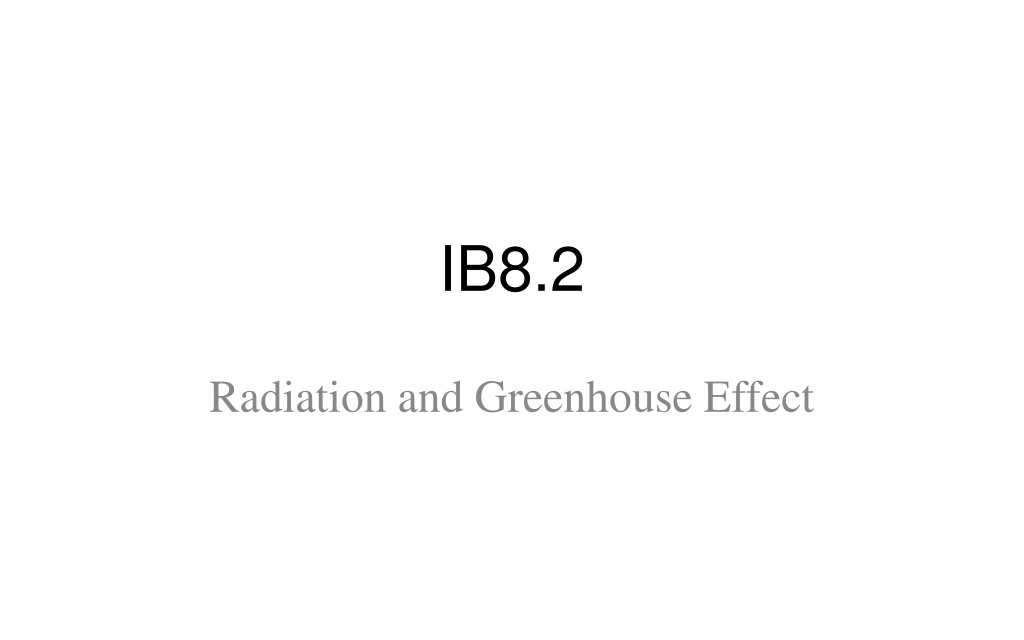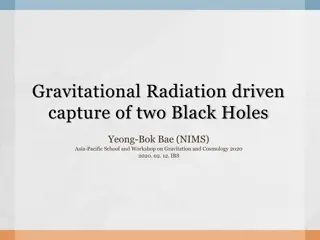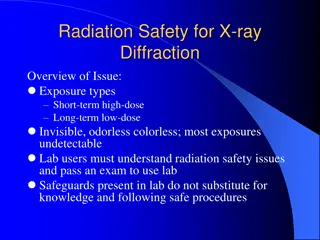Radiation and Black Body Radiation in Astrophysics
Explore the concepts of radiation and black body radiation in astrophysics by analyzing the peak emissions of the Sun, Earth, and distant stars. Calculate black body radiation peaks, temperatures, and power outputs for various celestial bodies, as well as heat transfer rates in different scenarios.
Download Presentation

Please find below an Image/Link to download the presentation.
The content on the website is provided AS IS for your information and personal use only. It may not be sold, licensed, or shared on other websites without obtaining consent from the author. Download presentation by click this link. If you encounter any issues during the download, it is possible that the publisher has removed the file from their server.
E N D
Presentation Transcript
IB8.2 Radiation and Greenhouse Effect
4. The sun's surface temperature is 5,778 K. What is the peak black body radiation emitted by the sun? What part of the EM spectrum does this wavelength come from? (Use your Google machine) (502 nm - visible)
5. The average temperature of the Earth is 14 oC. What is that in Kelvins, and what is the peak black body radiation for that temperature? What part of the EM spectrum does that radiation come from? (287 K, 10.1 m - IR)
6. A distant star had a BBR peak of 410 nm. What is the temperature of the surface of the star in K? (7,070 K)
7. Another star has a BBR peak of 780 nm. What is the temperature of the surface of the star in K? (3720 K)
10. The Sun has a surface temperature of 5,778 K, a radius of 6.96x108 m. Assuming it is a perfect black body, calculate the total power output of the sun. (3.85x1026 W)
11. The earth has an average surface temperature of 287 K and a radius of 6.38x106 m. At what rate does it radiate energy to space? (1.97x1017 W)
12. A 100. Watt incandescent light bulb has a filament temperature of 2810 K. What is the area of the filament in m2 if the emissivity is 0.55? (What is the peak BBR for this filament? Visible light is 400 to 700 nm...) (5.1x10-5 m2, 1.0x10-6 m or 1.0 m)
13. A person with a skin surface area of 1.6 m2 and temperature of 32 oC is in a room where the dark absorptive walls are at a temperature of 18 oC. What is the net rate of heat transfer if the emissivity of their skin and clothing is about 0.68? ( P = e A(T4 - T4) ) (92 W)
14. A radiator in a room is radiating energy at a rate of 345 Watts through a radiant area of 1.80 square meters. It has an emissivity of 0.890, and the room it is in has an ambient temperature of 18.0 oC. What is the temperature of the radiator in degrees Celsius? (50.6 oC)
15. An aluminum roof has an albedo of 0.890. If 1200 Wm-2 of solar radiation is incident on the roof, what is the reflected intensity, and what is the absorbed intensity? (1070 Wm-2 reflected, 132 Wm-2 absorbed)
16. A black asphalt roof has an albedo of 0.0900. If 1200 Wm-2 of solar radiation is incident on the roof, what is the reflected intensity, and what is the absorbed intensity? (108 Wm-2 reflected, 1092 Wm-2 absorbed)
17. What should the albedo be of a solar heater if it is to absorb 95.0% of the incoming light? (0.050)
18. A piece of metal lying in the sun measures 0.680 m by 0.543 m and has an albedo of 0.68. If it is absorbing 416 Wm-2, what must be the intensity of the light hitting it? (1300 Wm-2) What amount of energy will it absorb in a minute? (9.22 kJ)
19. A solar water heater has an albedo of 0.0452. What area must it have if it is to absorb 11.6 MJ in one hour when the intensity of the solar radiation is 1150 W m-2? (2.93 m2)
20. A star has a radius of 3.50x108 m and a temperature of 4280 K. What is the power output of the star? (Its luminosity) What is the intensity of light from it in Wm-2 if you are 1.30x1011 m from it? (2.93x1025 W, 138 Wm-2)
21. The intensity of a star is 1650 Wm-2 from a distance of 1.40x1011 m. What is the power output of the star? What is the temperature of the star's surface if it has a radius of 9.30x108 m? (4.06x1026 W, 5070 K)
22. 1450 Wm-2 of energy is incident on a planet whose upper atmosphere has an albedo of 0.230. What intensity of light gets through the upper atmosphere, and what is the average intensity over the whole surface of the planet? (1116.5 Wm-2, 279 W/m-2)
23. A planet has an average absorbed incoming energy intensity over its entire surface of 295 Wm-2, and its upper atmosphere has an albedo of 0.330. What is the energy intensity incident from space on the upper atmosphere? (1761 Wm-2)
24. What would be the equilibrium temperature of the earth if is absorbing on the average 258 Wm-2 from the sun (it isn't), and we ignored the greenhouse effect? (we can't) (260. K)
25. A planet with no atmosphere has an average surface temperature of 316 K. What is the average absorbed energy intensity over the surface of the planet from the star it orbits? What is the maximum intensity incident on planet? (565 Wm-2, 2261 Wm-2)
26. A planet has an upper atmosphere albedo of 0.105 and is at an equilibrium temperature of 13.0 oC with space. What is the incoming solar intensity from the star it orbits? (Assume there is no greenhouse effect due to the atmosphere) (1699 Wm-2)
1-2: A solar water heater has an albedo of 0.112. It measures 1.30 m by 2.15 m, and on a particular day, the intensity of the sun is 1150 W m-2. 1. What is the intensity of the reflected light, and the absorbed light? (129 W m-2 reflected, 1020 W m-2 absorbed)
1-2: A solar water heater has an albedo of 0.112. It measures 1.30 m by 2.15 m, and on a particular day, the intensity of the sun is 1150 W m-2. 2. What is the maximum energy it could absorb in an hour? (10.3 MJ)
3. A particular star has a peak black body wavelength of 517 nm. What is its temperature in Kelvins? (5610 K)
4. A power adapter has an outside area of 0.00540 m2, an emissivity of 0.720, and is dissipating 45.0 mW of heat by black body radiation to a room that is at a temperature of 20.0 oC. What is the temperature of the power adapter? (22.0 oC)
5. A planet has an upper atmosphere with an albedo of 0.170. Radiation from the star it orbits strikes the side facing the star with an intensity of 1370 W m-2. If there is no greenhouse effect, what would be the equilibrium temperature of the planet with space? (266.1 K, -7.05 oC)


![[PDF⚡READ❤ONLINE] Black Hole Astrophysics: The Engine Paradigm (Springer Praxis](/thumb/21503/pdf-read-online-black-hole-astrophysics-the-engine-paradigm-springer-praxis.jpg)
![[PDF⚡READ❤ONLINE] Cosmology and Particle Astrophysics (Wiley-Praxis Series in As](/thumb/21627/pdf-read-online-cosmology-and-particle-astrophysics-wiley-praxis-series-in-as.jpg)



















